Great Wall Motors “would rather die than make extended-range vehicles” because the technology is outdated
Great Wall Motors‘ senior vice president Mu Feng recently expressed strong views on extended-range electric vehicle technology, clearly stating Great Wall Motors “would rather die than make extended-range vehicles,” considering it an outdated technological approach.

At the 2025 Shanghai Auto Show on April 23, Great Wall Motors’ chairman Wei Jianjun emphasised that extended-range technology is merely transitional and incompatible with the company’s long-term development strategy. He stressed that Great Wall Motors will focus on pure electric and hybrid technology pathways instead of investing resources in developing extended-range models.
This stance aligns with previous statements from Mu Feng. Just on April 21, Mu described extended-range technology as “pseudo-electric” technology and highlighted several disadvantages, including:
- Extended-range vehicles primarily rely on fossil fuels as their primary energy source
- Extended-range vehicles have small battery capacity and limited pure electric range
- Extended-range vehicles offer inferior fuel economy compared to hybrid models
- Extended-range vehicles deliver lower overall performance than pure electric vehicles
Wei Jianjun’s statement further confirms Great Wall Motors’ rejection of extended-range technology, indicating the company will maintain its current technological direction and focus on developing hybrid and pure electric technologies.

Notably, Wei’s position starkly contrasts with strategies adopted by some other automakers in the market, such as Li Auto, which continues to promote extended-range electric vehicle models heavily.
Other professionals hold different views from Great Wall Motors, with Chinese Academy of Engineering academician Yang Yusheng emphasising that extended-range technology is not transitional but will be one of the main automotive technologies of the future. In 2021, only four products in the automotive industry used extended-range technology, but by 2024, more than 50 extended-range electric vehicles were launched that year alone.
Yang Yusheng has made predictions about market share in China’s automotive market: By 2027, extended-range vehicles are expected to account for approximately 1/3 of sales, pure electric vehicles 1/3, and fuel vehicles 1/3. By 2030, the proportion of extended-range and plug-in hybrid vehicles will increase to around 55%, pure electric vehicles will maintain around 30%, while fuel vehicles will decrease to 15%.



